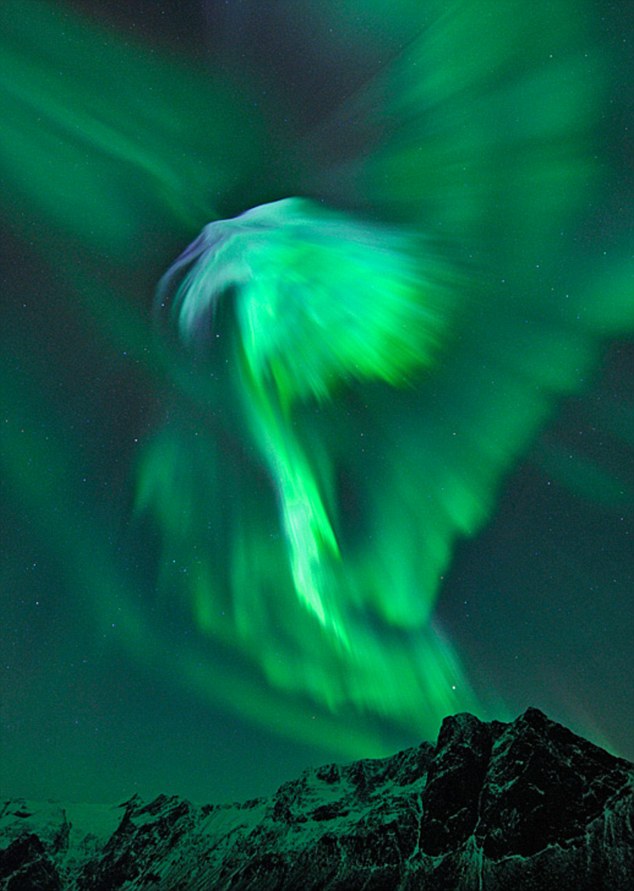This is the first post in a series of posts written by AccuWeather Astronomy expert Daniel Vogler. This post is meant to be used over and over again as a reference item when the Sun is busy.
All too often, we get asked during a solar flare event, “What should we expect? Where do we look? When? Will I see it?” Well, this will hopefully answer those questions as simply as possible. First off, we need to understand what we are looking at and what causes it.
The Aurora borealis, or Northern Lights, are the result of the collision of plasma-type matter with the Earth’s magnetosphere. When the magnetic field in the solar wind and the magnetic field of the magnetosphere are anti-parallel, the fields can melt together, and the solar wind can drag the magnetospheric field and plasma along. This is the southward Bz I talk about from time to time. Eventually, the magnetosphere responds by dumping electrons and protons into the high latitude upper atmosphere where the energy of the plasma can be dissipated. This, then, results in aurora.
The aurora looks like an oval donut, and the Earth rotates underneath it. For this reason, the oval is farthest south at your location near local midnight (12 a.m.-3 a.m. local time). This does not mean, however, that during a strong geomagnetic storm, will be best viewed at midnight.
Look northward toward the pole (south if in Southern Hemisphere).
Solar Cycle 24 is currently just getting underway and will peak some time around mid-2013. This means that the sunspot count will be at its highest point, meaning more chances for auroras.
Here are some keywords that you will hear often as the Solar Cycle gets underway:
Solar Flares and their size: sudden brightenings observed over the Sun surface or the solar limb, which are interpreted as large energy releases of up to 6 ? 10^25 joules of energy. Broken into different letter categories:
C – Weak
M – Medium
X – Strongest
Coronal Mass Ejection (CME for short):
a massive amount of plasma released due to the instability of the coronal magnetic field. Consists of mainly electrons and protons, the main reason for the aurora effect.
Geomagnetic Storm:
a temporary imbalance of Earth’s magnetosphere. Allows the protons and other charged particles to enter the thermosphere.
There are five distinct levels of intensity of the geomagnetic storm, which determines how far south the aurora will travel.
G1 (Minor)
Power systems: weak power grid fluctuations can occur.
Spacecraft operations: minor impact on satellite operations possible.
Other systems: migratory animals are affected at this and higher levels; aurora is commonly visible at high latitudes (northern Michigan and Maine).
G2 (Moderate)
Power systems: high-latitude power systems may experience voltage alarms, long-duration storms may cause transformer damage.
Spacecraft operations: corrective actions to orientation may be required by ground control; possible changes in drag affect orbit predictions.
Other systems: HF radio propagation can fade at higher latitudes, and aurora has been seen as low as New York and Idaho (typically 55° geomagnetic latitude)
G3 (Strong)
Power systems: voltage corrections may be required, false alarms triggered on some protection devices.
Spacecraft operations: surface charging may occur on satellite components, drag may increase on low-Earth-orbit satellites, and corrections may be needed for orientation problems.
Other systems: intermittent satellite navigation and low-frequency radio navigation problems may occur, HF radio may be intermittent, and aurora has been seen as low as Illinois and Oregon (typically 50° geomagnetic latitude)
G4 (Severe)
Power systems: possible widespread voltage control problems and some protective systems will mistakenly trip out key assets from the grid.
Spacecraft operations: may experience surface charging and tracking problems, corrections may be needed for orientation problems.
Other systems: induced pipeline currents affect preventive measures, HF radio propagation sporadic, satellite navigation degraded for hours, low-frequency radio navigation disrupted, and aurora has been seen as low as Alabama and northern California (typically 45° geomagnetic latitude)
G5 (Extreme)
Power systems: widespread voltage control problems and protective system problems can occur, some grid systems may experience complete collapse or blackouts. Transformers may experience damage.
Spacecraft operations: may experience extensive surface charging, problems with orientation, up-link/down-link and tracking satellites.
Other systems: pipeline currents can reach hundreds of amps, HF (high frequency) radio propagation may be impossible in many areas for one to two days, satellite navigation may be degraded for days, low-frequency radio navigation can be out for hours, and aurora has been seen as low as Florida and southern Texas (typically 40° geomagnetic latitude)
Kp Index
A scale in which helps determine the southern edge of the auroral oval at local midnight
1-9, 1 being the lowest, closer to the poles and 9 being the highest, farthest south.
1-4 = no geomagnetic storm occurring, auroras mainly around the pole
5 = G1 (Michigan, Maine)
6 = G2 (New York, Idaho)
7 = G3 (Illinois, Oregon)
8 = G4 (Alabama, northern California)
9 = G5 (Florida, South Texas)
Please use this as a reference when dealing with solar events as the Solar Cycle kicks in to high gear.
Please join in or begin a conversation by clicking here. You can leave your comments, as well as be part of a community where discussions on any astronomy subject are taking place. We are now over 2,400 likes. Tell your friends about this site and blog, and have them weigh in on some exciting issues. We encourage open discussion and will never criticize any idea, and no negative conversation will be allowed.
My experts will keep you up to date on any astronomy-related subject. Please feel free to share your opinions!
And please keep the astronomy pictures coming! They have been simply amazing! We had an amazingly busy week last week, the busiest by far here at AWA. Please keep it up. Ask questions, comments, share anything!
From Accuweather.com 
